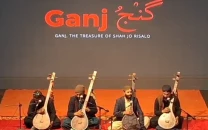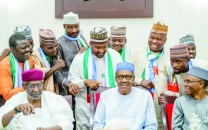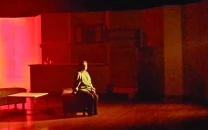From wedding photographer to Pakistan’s premier cinematographer
Cinematographer Rana Kamran on career trajectory and need for Pakistani cinema to create a visual language of its own

Rana Kamran on the sets of a recent TVC. PHOTOS: PUBLICITY
Amidst the glitz and glamour of the film industry, there exists one lone ranger who undertakes a lot of the hard work but is rarely ever recognised. To paraphrase visionary film-maker Cecil B DeMille’s words, “This figure, a giant in his industry, is the cinematographer … the sine qua non of a profession which often boasts that no one in its ranks is indispensable.” In almost every film industry across the world, cinematographers usually lurk in the background and are denied the kind of plaudits enjoyed by writers, directors and actors. It seems like the only place they can really be seen holding their own is on the sets, either perched next to the director or preparing the rest of the crew for a scene.
'It feels like London': Inspiration and awe as Karachi landmark takes new form

Though it may be unfair to regard Rana Kamran as a shadow in the dark, it is only over the past few years that the Director of Photography (DOP) has managed to make an indelible mark for himself. For instance, a year has passed since Na Maloom Afraad (NMA) first saw the light of day but Rana continues to receive laurels for his impressive work in the comedy hit till today.
Despite this, the cinematographer believes there is nothing exceptional about his work. Speaking with The Express Tribune, Rana called it a stroke of luck from being in the right place, at the right time. “When Nabeel Qureshi wrote the screenplay for NMA, the first thing I said was that the script is so comprehensive, it wouldn’t require much from a DOP,” he shared. “If you look at it now, you would note that the shots are actually very basic and static. We simply tried to create perfect ambience and light the scenes,” added Rana.
Film screening: UN raises human rights awareness through cinematography
Having said that, the DOP – who has been working in the entertainment industry for close to 15 years – still terms his collaboration with the NMA team as “one of the most rewarding experiences” of his career. Interesting, there was once a time – some two decades ago – wherein working in movies seemed like a distant possibility for him. In fact, the thought had never even crossed his mind for he was busy making a living as a wedding photographer-cum-videographer. At that time, wedding photography was all the rage, but Rana, who also lent his talents to Wajahat Rauf’s Karachi Se Lahore, noticed an influx of private television channels and production houses. At the turn of the millennium, he graduated from weddings to the small screen, branching out to drama serials and music videos. To outsiders, this career jump may seem drastic but in Rana’s words, it was simply logical progression. “It’s just like an academic career: first you go to pre-school, then school, then college and then university,” he stated.

Even now, the cinematographer professes that the long hours he spent at strangers’ weddings, filming with a large VHS camcorder mounted on his shoulder, have not been futile. After all, it was here that he learnt the nitty-gritty of his craft. “I learnt a lot just by covering weddings … from still photography in particular,” shared Rana. “I learnt how to capture footage and that static and fixed shots need to be engaging so that the viewer remains engaged.”
Unlike most of his contemporaries, Rana has already displayed a knack for mainstream and independent cinema, through his work in movies like NMA, Mah-e-Meer and the upcoming Quetta. By his own admission, he is a sucker for natural light – so much so that even during the course of this conversation, he kept working out ways to light up his own workspace. He owes this habit to his time in TV production; it peaked during the principal photography of Quetta which has majorly been filmed in natural light. Describing his experience of working on the upcoming Murtaza Chaudhry drama, Rana said the project came to him at the perfect time, right after he was done with Mah-e-Meer. By then, he had also become well-versed in the fundamentals of shooting a feature-length film. “In Quetta, I was handed something completely different. I had a very open frame and the natural light was so perfect, I didn’t even need to add additional lighting [barring three or four sequences],” he revealed.
Given the visual harmony that Rana has forged with multiple directors, he has made it clear that he harbours no ambitions of directing himself. Hinting at the dearth of cinematographers in Pakistan, Rana is more than content as a DOP and helping Pakistani cinema develop its own visual language. But for that to happen, he claims local cinema will have to let go off its past. “There are so many innovations taking place in terms of film-making technology [and styles] that it has become near imperative for film-makers and audiences to keep moving forward,” he said. “You never know, people might not even remember NMA 10 years from now.” But with numerous high-profile projects such as Quetta, Janaan and Actor In Law in the pipeline, it seems unlikely that Rana’s work will be forgotten any soon.
Published in The Express Tribune, January 25th, 2016.
Like Life & Style on Facebook, follow @ETLifeandStyle on Twitter for the latest in fashion, gossip and entertainment.



















COMMENTS
Comments are moderated and generally will be posted if they are on-topic and not abusive.
For more information, please see our Comments FAQ